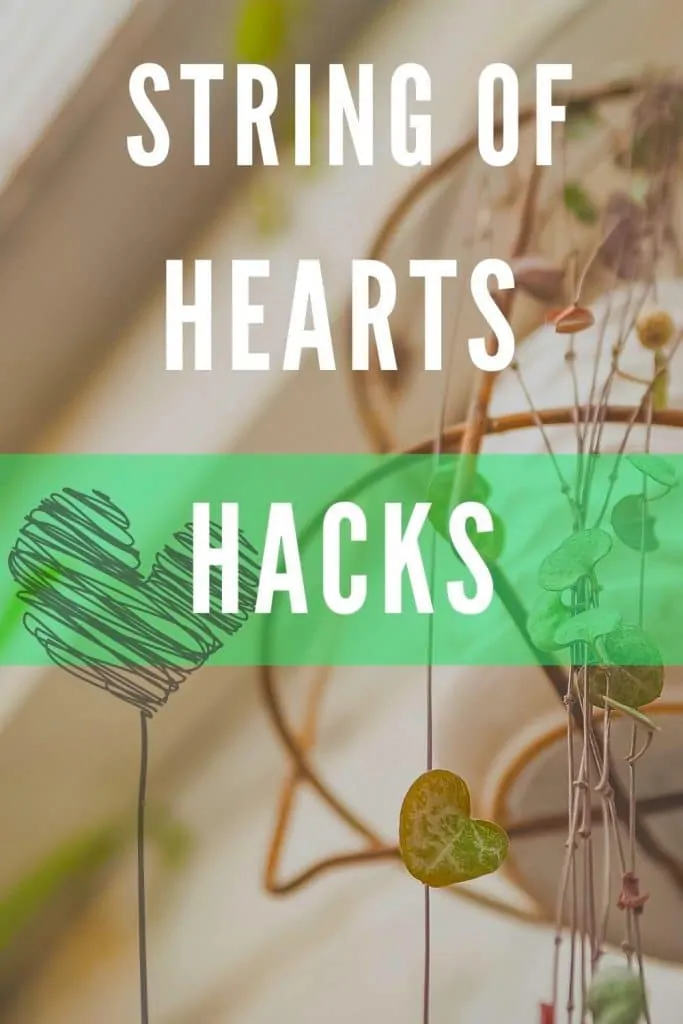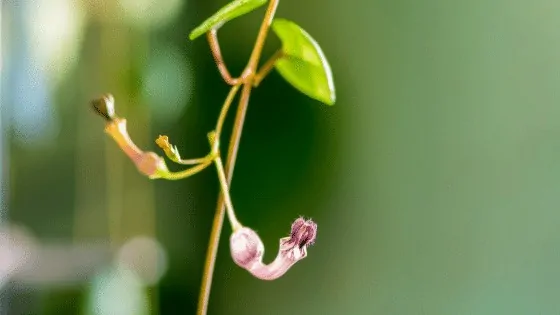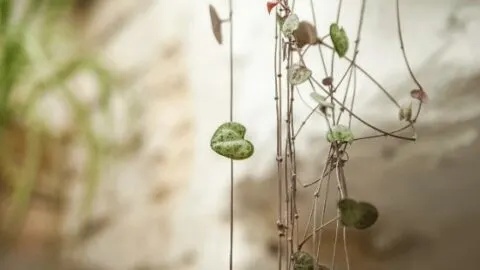Table of Contents
String of Hearts or also called Ceropegia Woodii or Rosary Vine is a trailing plant with beautiful heart-shaped leaves. What most people don’t know is that this plant is a succulent vine. Whenever you hear succulent you should also hear less watering. This plant is prone to root rot caused by wet soil.
Apart from limited watering needs the String of Hearts or also called Chain of Hears or Rosary Vine is an easy to care for houseplant. It is a plant found in South Africa.

Table of Contents
String of Hearts Care
SOIL
A succulent cactus mix is the best for the Sting of Hearts. You do not want this plant to stay in wet soggy soil as you would quickly have to say bye-bye to your houseplant. Whenever you hear succulent or cacti soil it usually means a potting mix that contains coir, pumice and some potting soil.
As with almost all houseplants your potting mix needs to be well-draining so water can flow through the substrate and will not lead to soggy soil. To increase drainage, small pebbles or parts of an orchid mix can be added.
LIGHT
Bright light is best for your Chain of Hearts. Some direct light is fine as long as it is not throughout the whole day. Direct light in moderation can actually bring out the best colours and healthiest leaves. When growing String of Hearts outdoors, keep them in bright shade.
The spacing of the String of Hearts leaves is a good indicator of whether your plant gets enough light. The wider the spaces between leaves are, the more in need of light your houseplant is. If you, therefore, spot wide spacings, move your plant closer to a light source or window.
A south or west-facing window with bright light is the best choice in case your house or apartment has any.
WATERING
String of Hearts is a succulent vine plant that likes to be kept on the dry side. Let the soil dry out completely before watering. Water thoroughly when watering. Although it depends on your conditions watering should be done about once every two to three weeks.
In doubt water less than more frequently. String of Hearts has underground rhizomes similar to a ZZ plant that can store water for an extended time.
Reduce watering in winter when the String of Hearts goes dormant.
TEMPERATURE
Native to South Africa, String of Hearts can be kept in temperatures between 64°F – 75°F (18-24°C) which will be the average temperatures in most households. However, it generally does better in warmer conditions and thrives in temperatures in the lower 80s range. Make sure however that temperatures are not dropping below 60°F (16°C).
HUMIDITY
Keep humidity between 40-50%. Most households will have humidity that is around this range. You, therefore, won’t need any kind of vivarium or humidifier to keep your String of Hearts happy and healthy.
FERTILIZER
Liquid fertilizer at half-strength can be used in Spring and Summer once a month. An alternative method is using worm castings as this is a great way to fertilize your Sting of Hearts, too. Do not fertilize in winter as your Chain of Hearts will go dormant during this period.
PROPAGATION
This plant is a joy to propagate. On its vines, it produces little beads that can be used for propagation. Once the beads are touching soil they will start to grow roots on their own. In order to propagate this succulent vine, you can trim parts of the vines by doing cuttings.
Cut just right above one of the little beads that feel like little knobs and make sure the vine contains several leaves as these will help with photosynthesis. Read our in-depth propagation instructions below for more info on how to propagate your Sting of Hearts.
The best seasons to propagate Sting of Hearts is spring and summer.
GROWTH
String of Hearts is a trailing plant that can trail to a size of 5 feet or more (152cm+). Can String of hearts growing upwards you may ask? The answer is no as they are cascading and not growing upwards.
POTTING
Use a pot with draining holes. From our experience terracotta pots are optimal as they help to take in the excess water. Repot when the String of Hearts looks root-bound. Repotting is best done in spring.
Flowering
Although this houseplant has already stunning leaves, the Sting of Hearts also produces tiny little flowers from spring to summer. The flowers are shaped like little chalices and have a light rose colour.

String of Hearts Flowering
String of Hearts Faux Plant
String of Hearts does not only look great as a real plant. There are faux String of Hearts that look almost as good as the real deal. Sometimes you are not able to offer the right conditions in terms of light and temperatures or you just don’t want the hassle of keeping a plant alive. In this case, a fake String of Hearts is the right choice for you.
You can get an artificial String of Hearts on Amazon.
String of Hearts Variegated
The Variegated String of Hearts is the beautiful variation of this beautiful trailing plant. Its leaves are also heart-shaped but are green and pink in colour. Although this variant is rarer than the non-variegated type it is fortunately not as rare as a Variegated Monstera Deliciosa.
String of Hearts How to Propagate
String of Hearts is easy to propagate. We dedicate this section to show you the most successful propagation methods. An easy method is to take several cuttings of a few inches long and put them either into water or directly into the soil.
Water Propagation
Let’s look into how to propagate String of Hearts in water:
- Trim of as much of the hanging vines as you want preferably in spring.
- Put the cuttings into a glass with water and remove the bottom leaves so none of the leaves is in the water.
- Change the water every week. This prevents the water from going bad and makes sure there is new oxygen in the water.
- After a few weeks, roots will start to grow from the tubers of your plant and you can place your cuttings into soil. From our experience it takes 3-4weeks. Ceropegia Woodii generally roots quickly.
Soil Propagation
Soil propagation is a little more tricky than water propagation from our point of view. But that doesn’t mean it can’t be very successful. Here are the steps to propagate String of Hearts in soil:
- Take cuttings of your plant
- Prepare a suitable potting mix for cuttings that is airy and will stay slightly moist
- Either put your vines and tubers on the potting medium or slightly stick them into the soil
- Use a chopstick or any stick you have available to make a little hole into the dirt
- Put the stem into the hole and push some soil against it so the vine stays put.
- Make sure that no leaves are underground as the leaves would rot.
- You can also dip the ends of the strings in rooting hormone as this will increase the chances of success.
- Wait 3-4 weeks until the cuttings start to produce roots. Once new leaves emerge, you can be sure that your propagation attempt worked.
This method works for pure cuttings as well as for tubers. Another way is to propagate from seeds.
String of Hearts Propagation with Tubers
An alternative is the tuber propagations. The older your String of Hearts gets, the more numerous and bigger, in general, are the tubers that grow along with the vines. These look like little round pearls on a chain.
How to propagate String of Hearts using tubers:
- Find sections on your vines with tubers
- Place the tubers onto potting soil. Use either the soil that is in the pot of your main plant or place the tubers onto soil within a different pot.
- The great thing about tuber propagation is that you do not need to cut the vines off and you can leave them on your String of Hearts
- Roots will form on the tubers and once the roots are present, you can cut of the vines from the main plant.
- Voila, you propagated String of Hearts from tubers.
Common Problems
Dropping Leaves
Overwatering is the main reason for String of Hearts to die. It is also the main cause for leaves starting to fall off. The leaves first turn yellow and then start to fall off. The next step is that the whole plant will start to rot in case you won’t hold back on watering. Let’s look at the remedy to avoid that scenario.
Remedy
Since overwatering is the cause, reduce watering immediately. Ceropegia Woodii is a succulent vine and therefore needs less watering and prefers the soil to dry out completely before watering. The best suggestion is to rather under- than overwater when leaves are dropping.
String of Hearts going yellow
Yellowing leaves can have two causes. Either you are overwatering, one of the most common causes for yellow leaves on any plant or, your plant is kept too cold. Low temperatures can cause yellow leaves on String of Hearts in a heartbeat. This is especially common in winter months when temperatures might easily go below 60°F (16°C) if your room is not heated.
Apart from low temperatures, the cause might be overwatering. Check by putting a finger into the soil. If it feels soggy and wet after a couple since you watered you are overwatering or the potting soil you are using is not ideal.
Remedy
Remove the old potting soil and replace it with well-draining soil to prevent rotting. Chunky bits in your potting soil will help air pockets to form and ensure good drainage. If you are simply watering too much, reduce watering and only water when your potting soil feels dry to the touch.
Dormant
This houseplant goes dormant in Autumn and Winter. It will start to grow slower or stop entirely. That is the normal cycle for your plant so you do not need to worry. But what you need to do is to change your watering schedule and water less as less growth means less need for water.
Remedy
There is no remedy needed as this is the normal cycle it goes through.
String of Hearts leaves curling
If leaves on your Chain of Hearts are curling, there is a good chance that you are underwatering your houseplant. Although difficult to do, this succulent like plant needs water every now and then. The prefer periods of drought but if they last too long and the water reservoirs in the tubers are exhausted they develop curling leaves.
Remedy
Get back to a regular watering schedule and water every 2-3 weeks. The frequency heavily depends on the environment. When growing String of Hearts outdoors in dry and warm conditions you may even have to water daily. In general indoor conditions, it will be more like every 2-3 weeks.
Mold
When the soil stays moist for too long, fungus that decays organic matter ist starting to build up. It looks like a fuzzy white substance that starts to grow on the surface of your soil.
Remedy
Change the location of your plant to a place where it is warmer and has more light so water will be used quicker. In addition, make sure that the used potting soil is well-draining.
Root Rot
String of Hearts are sensitive to overwatering and also root rot as they are comparable to a succulent in terms of watering need. It doesn’t need much to overwater this bundle of hearts.
Remedy
The best thing you can to prevent root rot is to stick to your watering routine and remember when you watered your plant the last time. The second best thing you can do is to stick your index finger or any other finger into the soil to test the humidity level.
The more you do that the better your understanding will be how a soggy soil feels different in comparison to dry soil. As a general rule of thumb, do not water when your soil feels wet. These plants like a drought period in-between waterings.
My Chain of Hearts is dying
Oh, snap. You are about to kill this magnificent String of Heart plant. This will break my and probably your heart, pun intended. But do not worry, Plantophiles to the rescue. No one wants you to say that your String of Hearts ends dying.
We suggest checking for different causes that might lead to the conclusion that your plant is dying. How does it look like, are leaves yellow? Are they falling off? Can you spot any pests? Is the soil soggy or completely dry? By looking at the common problems in this section and the potential remedy we are confident that you have a chance in bringing your plant back to life.
Common Pests on String of Hearts
Pests that love to attack your String of Heart are Mealybugs, Aphids and Scale. Check your plant at least weekly and also have a look at the underside of leaves. Watch out for small insects and also webs. Some pests are also present at the soil level. Lets now have a look at each of the 3 described villains.
Mealybugs
Mealybugs often leave sticky residue on plants and look like cotton. The worst thing is that Mealybugs quickly spread from plant to plant. It is, therefore, best to isolate infected plants. They are a soft-bodied and plant sap-sucking evil that only does little damage when the number is limited. Once the population grows, leave are starting to yellow and curl from their attacks and will weaken the plant.
Remedy
Wash your String of Heart with diluted soap, one part water and one part soap. After washing with soap use diluted rubbing alcohol on the vines and leaves and repeat this process several times every two weeks until no stick residue or pests can be found anymore.
Aphids
Another sap-sucking insect that is feeding off the plant tissue. Aphids are tiny and hard to spot. They only reach a size of about 1/4 inch are pear-shaped and have long antennas. They can have multiple colours, grow fast and breed like crazy. So you will have to get them under control as fast as possible. Fortunately, they are slow-moving and if you spot them early they are easy to get under control.
Remedy
Spray cold water on the leaves. A blast of cool water is something Aphids clearly won’t appreciate. If you are dealing with a large infestation you can also go into the kitchen and grab some flour. Dust your plant off with such and constipate the pests.
Scale
Scale have shell-like covers and do not move. They love to suck plant sap from innocent houseplants. They excrete a sticky substance called honeydew on plants which leads to black mould building upon the foliage. Scale infest leaves and stems on the String of Hearts and once you spot mould you have another indicator that you might be dealing with Scale. Scale infestations lead to plants look wilted and sick. In order to get rid of Scale quickly, let’s look at the remedy.
Remedy
Use soap water and neem oil to get rid of scale. Dishwashing liquid can be used on leaves and stems. If there is also fungus present use a mix of baking soda and water and apply it on your String of Hearts. Make sure to wash everything off afterwards and never use it on a hot and bright sunny day as you might burn your plant that way.
Frequently Asked Questions for String of Hearts
Is String of Hearts cat save?
This plant is not toxic to neither cats nor dogs according to the California Poison Control System.
String of Hearts not growing?
If your String of Heart has insufficient light it will not grow well or even not grow at all. These plants need bright indirect light. The best place indoors is to grow them in a south-facing or west-facing window.
String of Hearts not rooting?
If your String of Hearts cuttings are not rooting you are either trying to propagate in Autumn or Winter or you are using the wrong methods. Propagation works best in Spring and Summer and String of Hearts can be propagated by stem cuttings, tubers in either water or soil.
What is the natural habitat of the String of Hearts?
This plant is native to South Africa and grows in a tropical and subtropical climate.
Can you keep a String of Hearts in low light conditions?
String of Hearts grows best in bright indirect light in a south or west-facing window. You can grow it in lower light conditions but it will certainly not thrive and the distance between leaves will become bigger.
If you are a fan of trailing houseplants, you might also like the String of Pearls.

Daniel has been a plant enthusiast for over 20 years. He owns hundreds of houseplants and prepares for the chili growing seasons yearly with great anticipation. His favorite plants are plant species in the Araceae family, such as Monstera, Philodendron, and Anthurium. He also loves gardening and is growing hot peppers, tomatoes, and many more vegetables.


